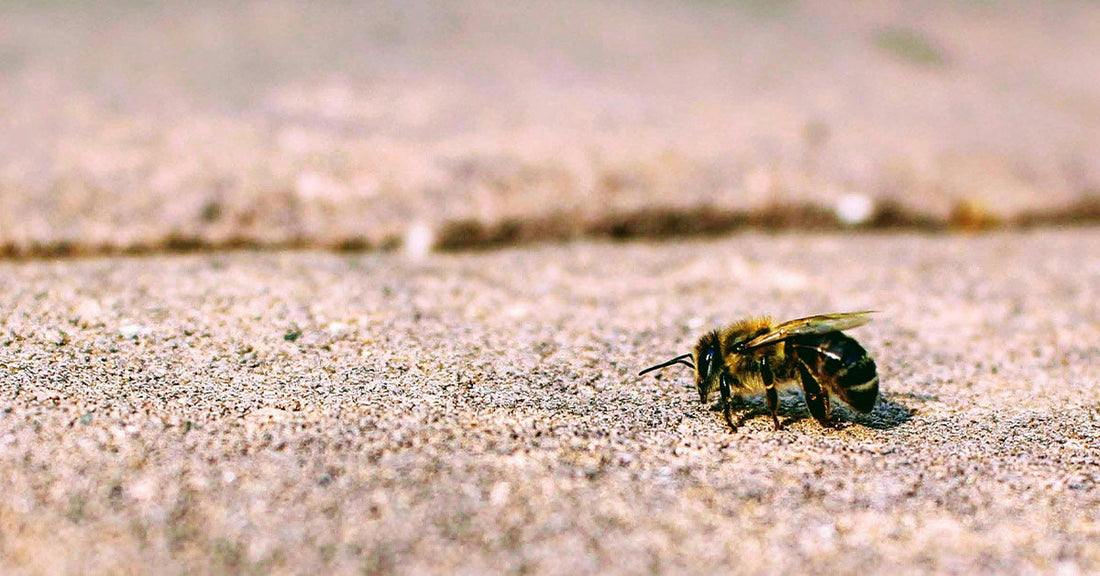This Common Rescue Tip for Bees Could Be Doing More Harm Than Good
Matthew Russell
Finding a motionless bee on the ground can be alarming. Your first instinct might be to rush in and help—but pause. That grounded bee might not be in trouble at all. Sometimes, it’s just resting.
If the bee is on a flower, it’s likely doing just that. As Buzz About Bees explains, male bees often sleep in flowers overnight, while others pause during long foraging trips to conserve energy. A bumblebee queen, for instance, can rest for up to 45 minutes between flights.
But if the bee is on a hard surface like a sidewalk, especially at risk of foot traffic or bad weather, it may need your help.

Most adult bees only live for 4 to 6 weeks.
Assess Before You Act
The key is knowing when to intervene. Bees have short lifespans—four to six weeks for most adults—so many you see on the ground are simply at the end of their natural lives. According to Honey Bee Suite, signs of aging include ragged wings, bald patches, or a slow crawl. These bees won’t recover, even with your best intentions.
However, if the bee is visibly alive, upright, and its wings seem intact, a simple move could help. “If the bee is still moving and in a risky location… move them with a leaf, twig or even clothing,” Amy Ross of Kent Wildlife Trust, told Yahoo UK. Placing them on a nearby flower is often all they need.

Grounded bees are often at the end of their natural lives.
To Feed or Not to Feed?
There’s a growing debate about feeding sugar water to bees. Ross warns against it, noting it lacks the nutrients bees need and can actually harm them. Instead, she advises moving the bee to a flower or shallow dish of water.
Still, in urban settings with no flowers in sight, a drop of sugar water may help. As Just Bee Honey points out, “we can’t always afford to be idealistic.”
A tired bee far from food might need an emergency sugar boost to survive.
If you go this route, mix two parts water with one part white granulated sugar. Avoid honey, as it can carry diseases harmful to wild bees, Buzz About Bees advises. Place a small drop near the bee—never on it. For added safety, dip a flower into the mixture and let the bee drink from the petals.

Not all bees on the ground need rescuing.
Keep It Natural, Keep It Short
If the bee is wet from rain, it may not fly simply because its wings are waterlogged. In that case, gently move it under shelter or into the sun. Do not bring bees indoors. As Revive a Bee warns, “lack of natural light and entrapment will distress them.”
A makeshift shelter—like an upside-down plant pot with a drainage hole—can give a damp bee space to dry and fly away when ready, Buzz About Bees reports.
When the Bee Doesn’t Fly Again
Not all bees can be helped. Some suffer from invisible injuries, age, or viruses like deformed wing virus, which leaves them grounded with twisted or absent wings. These bees are likely at the end of life, and as Honey Bee Suite notes, trying to prolong their lives may do more harm than good.

Bees sometimes rest between long foraging trips.
How to Help Beyond the Moment
If you want to make a lasting difference for bees, start in your garden. Planting native wildflowers, herbs, and even vegetables can provide vital food sources. Leaving patches of “messy” lawn with dandelions and clover helps too. And skip the pesticides.
Creating habitat—like bee hotels for solitary species—and avoiding disruption of underground nests gives these pollinators a fighting chance year-round.
“We need to create the conditions,” says Buzz About Bees, “and then let nature take its course.”

